Mingjun Xu
SciLitLLM: How to Adapt LLMs for Scientific Literature Understanding
Aug 30, 2024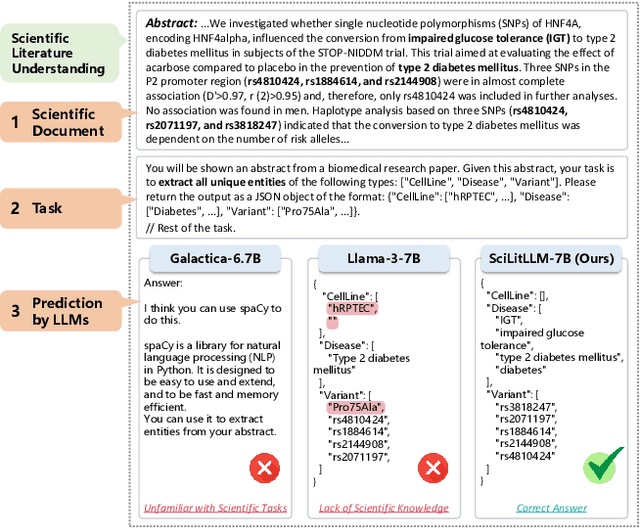
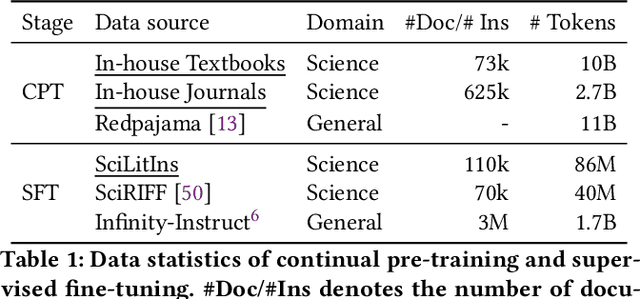
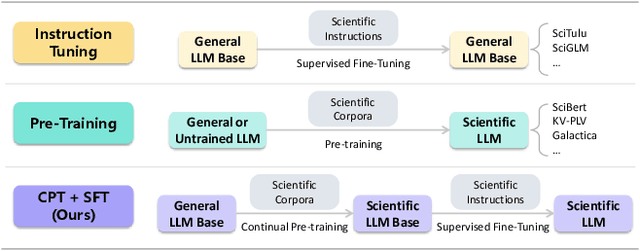
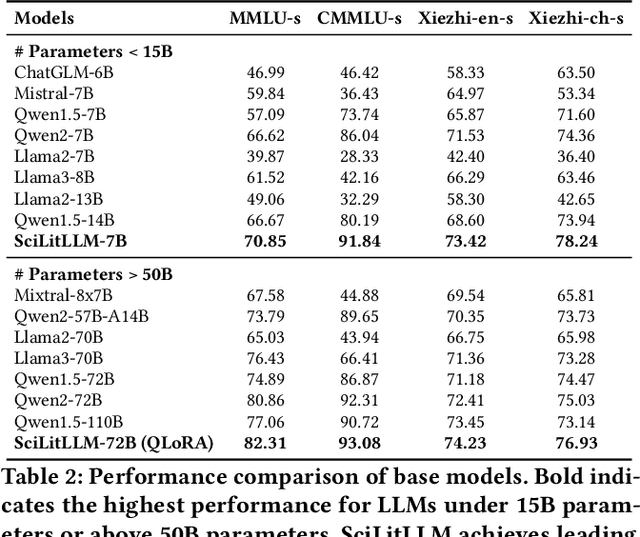
Abstract:Scientific literature understanding is crucial for extracting targeted information and garnering insights, thereby significantly advancing scientific discovery. Despite the remarkable success of Large Language Models (LLMs), they face challenges in scientific literature understanding, primarily due to (1) a lack of scientific knowledge and (2) unfamiliarity with specialized scientific tasks. To develop an LLM specialized in scientific literature understanding, we propose a hybrid strategy that integrates continual pre-training (CPT) and supervised fine-tuning (SFT), to simultaneously infuse scientific domain knowledge and enhance instruction-following capabilities for domain-specific tasks.cIn this process, we identify two key challenges: (1) constructing high-quality CPT corpora, and (2) generating diverse SFT instructions. We address these challenges through a meticulous pipeline, including PDF text extraction, parsing content error correction, quality filtering, and synthetic instruction creation. Applying this strategy, we present a suite of LLMs: SciLitLLM, specialized in scientific literature understanding. These models demonstrate promising performance on scientific literature understanding benchmarks. Our contributions are threefold: (1) We present an effective framework that integrates CPT and SFT to adapt LLMs to scientific literature understanding, which can also be easily adapted to other domains. (2) We propose an LLM-based synthesis method to generate diverse and high-quality scientific instructions, resulting in a new instruction set -- SciLitIns -- for supervised fine-tuning in less-represented scientific domains. (3) SciLitLLM achieves promising performance improvements on scientific literature understanding benchmarks.
Uni-SMART: Universal Science Multimodal Analysis and Research Transformer
Mar 15, 2024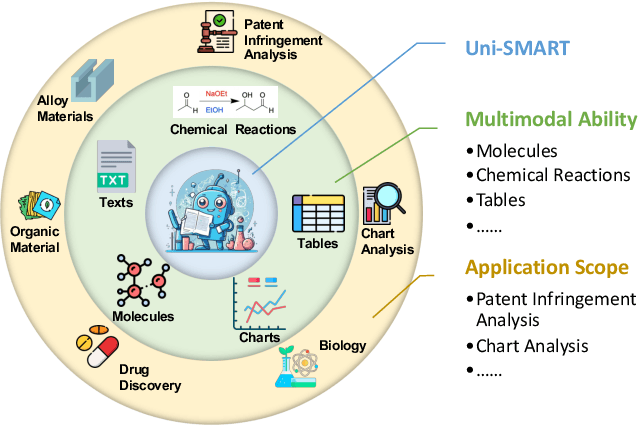
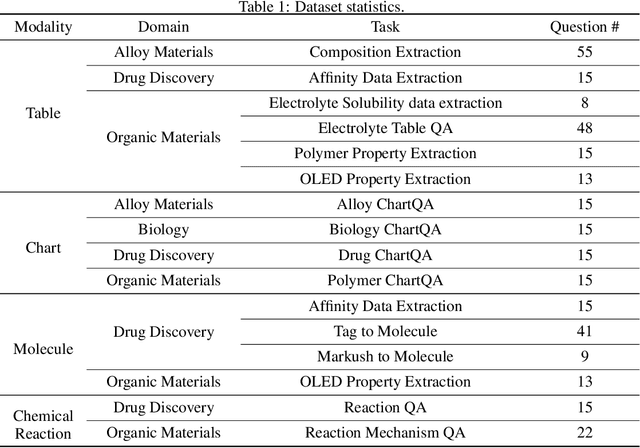
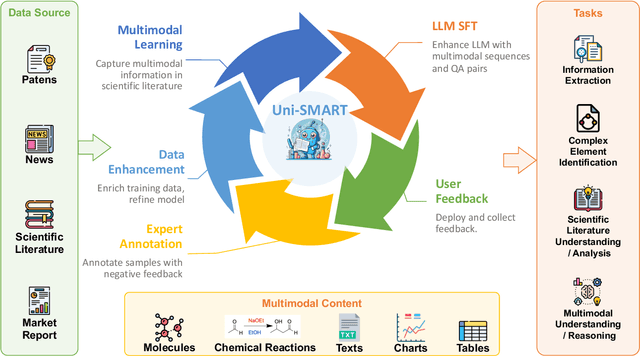
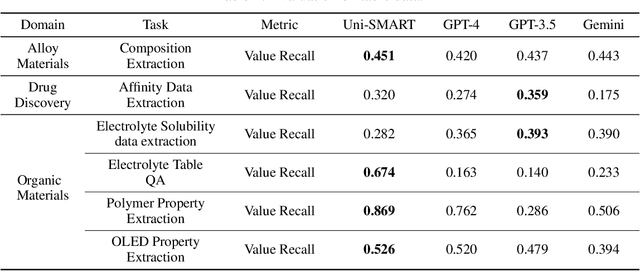
Abstract:In scientific research and its application, scientific literature analysis is crucial as it allows researchers to build on the work of others. However, the fast growth of scientific knowledge has led to a massive increase in scholarly articles, making in-depth literature analysis increasingly challenging and time-consuming. The emergence of Large Language Models (LLMs) has offered a new way to address this challenge. Known for their strong abilities in summarizing texts, LLMs are seen as a potential tool to improve the analysis of scientific literature. However, existing LLMs have their own limits. Scientific literature often includes a wide range of multimodal elements, such as molecular structure, tables, and charts, which are hard for text-focused LLMs to understand and analyze. This issue points to the urgent need for new solutions that can fully understand and analyze multimodal content in scientific literature. To answer this demand, we present Uni-SMART (Universal Science Multimodal Analysis and Research Transformer), an innovative model designed for in-depth understanding of multimodal scientific literature. Through rigorous quantitative evaluation across several domains, Uni-SMART demonstrates superior performance over leading text-focused LLMs. Furthermore, our exploration extends to practical applications, including patent infringement detection and nuanced analysis of charts. These applications not only highlight Uni-SMART's adaptability but also its potential to revolutionize how we interact with scientific literature.
A Survey on Image-text Multimodal Models
Sep 23, 2023



Abstract:Amidst the evolving landscape of artificial intelligence, the convergence of visual and textual information has surfaced as a crucial frontier, leading to the advent of image-text multimodal models. This paper provides a comprehensive review of the evolution and current state of image-text multimodal models, exploring their application value, challenges, and potential research trajectories. Initially, we revisit the basic concepts and developmental milestones of these models, introducing a novel classification that segments their evolution into three distinct phases, based on their time of introduction and subsequent impact on the discipline. Furthermore, based on the tasks' significance and prevalence in the academic landscape, we propose a categorization of the tasks associated with image-text multimodal models into five major types, elucidating the recent progress and key technologies within each category. Despite the remarkable accomplishments of these models, numerous challenges and issues persist. This paper delves into the inherent challenges and limitations of image-text multimodal models, fostering the exploration of prospective research directions. Our objective is to offer an exhaustive overview of the present research landscape of image-text multimodal models and to serve as a valuable reference for future scholarly endeavors. We extend an invitation to the broader community to collaborate in enhancing the image-text multimodal model community, accessible at: \href{https://github.com/i2vec/A-survey-on-image-text-multimodal-models}{https://github.com/i2vec/A-survey-on-image-text-multimodal-models}.
Multi-view Adversarial Discriminator: Mine the Non-causal Factors for Object Detection in Unseen Domains
Apr 06, 2023Abstract:Domain shift degrades the performance of object detection models in practical applications. To alleviate the influence of domain shift, plenty of previous work try to decouple and learn the domain-invariant (common) features from source domains via domain adversarial learning (DAL). However, inspired by causal mechanisms, we find that previous methods ignore the implicit insignificant non-causal factors hidden in the common features. This is mainly due to the single-view nature of DAL. In this work, we present an idea to remove non-causal factors from common features by multi-view adversarial training on source domains, because we observe that such insignificant non-causal factors may still be significant in other latent spaces (views) due to the multi-mode structure of data. To summarize, we propose a Multi-view Adversarial Discriminator (MAD) based domain generalization model, consisting of a Spurious Correlations Generator (SCG) that increases the diversity of source domain by random augmentation and a Multi-View Domain Classifier (MVDC) that maps features to multiple latent spaces, such that the non-causal factors are removed and the domain-invariant features are purified. Extensive experiments on six benchmarks show our MAD obtains state-of-the-art performance.
 Add to Chrome
Add to Chrome Add to Firefox
Add to Firefox Add to Edge
Add to Edge